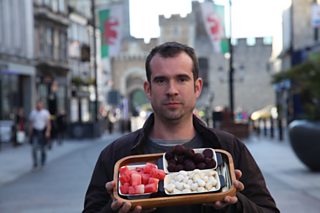Experiment protocol for the big blood pressure experiment
Aims / objectives
The primary aim/objective was to demonstrate blood pressure-lowering effects of one-week interventions of beetroot, watermelon and garlic in volunteers with high-normal or high blood pressure ≥130/85 mmHg.
Experimental design and methods
The design was an open-label/unblinded, randomised order, Latin-square/crossover illustrative experiment, with 1-week interventions of beetroot, garlic and watermelon, versus normal diet.
Blood pressures was measured, according to standard British Hypertension Society Criteria, by pharmacy healthcare assistants (with a pharmacist overseeing).
The sample size was chosen as 20-30 people based on a statistical analysis of the number of volunteers needed to show a statistically significant difference (using mixed models ANOVA, or t-tests) between the mean average blood pressure recorded at the end of each intervention week and also between the mean average blood pressure from home monitoring throughout each intervention week.
Baseline run-in phase
In order for the volunteers to familiarise themselves with the cuffs, and to get a truer baseline reading over a week, the volunteers were asked to take their BP readings morning and evening for one week before the intervention. The volunteers were shown how to use an automatic blood pressure monitor & cuff and were instructed to take their blood pressure in the morning, and in the evening for the week. The blood pressure readings were then recorded on forms and the results collated at the end of each intervention week. The blood pressures were also recorded each week in the rehearsal/meeting room.
Volunteers were given advice on which vegetables to consume as part of a low-nitrate diet during this run-in phase. Volunteers already using chlorhexidine mouthwash were advised to continue using it, but abstain during the beetroot (dietary nitrate) part of the experiment and also to avoid brushing the back of their tongue.
The volunteers then rotated through each of the following fruit or vegetable interventions (1 week each), in a randomised order:-
Intervention 1: (ideally) raw beetroot (minimum 240 g/day or 3 UK portions, containing ~3-6 mmol nitrate). Other high nitrate vegetables could also be consumed, such as green leafy veg, but volunteers were asked to avoid the other interventions – garlic and watermelon and mouthwash.
Intervention 2: garlic (minimum 2.5 g or 1 clove/day). Onions and shallots could also be consumed, but volunteers were asked to avoid the other interventions – beetroot and other high nitrate-containing veg and watermelon. Mouthwash (chlorhexidine) was offered to the volunteers to reduce unwanted tastes and odours.
Intervention 3: watermelon (2-3 slices/day). Total length of time of interventions, 3 weeks & 1 week run-in phase = 4 weeks. The amount of each food was portioned and provided to each volunteer according to previously established effective quantities.
The volunteers were shown the best way to prepare each food. A cooking demonstration showed that beetroot is best used raw in salads or in juice to prevent loss of nitrate in cooking, for example.
The group were asked to complete a food diary: this was in a ‘food diary checklist’ format and its purpose was to record any potential foods that might impact on the effects of the current food being studied. On the same document they recorded their BP measurements, volunteers were asked to tick and specify amounts of relevant foods: eg spinach, dark green leafy vegetables, celery etc.

